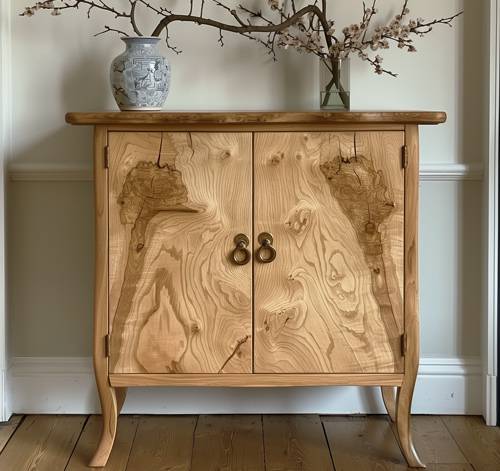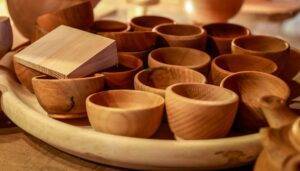Elm
The elm, Tree of the Year 2019, is one of the most beautiful native woods. Carpenters and craftsmen value its precious wood, which varies in colour from chocolate brown to light brown depending on the elm species. Its coarse-pored grain gives this wood a special charm.
Known as the ‘tree of good behaviour’, the elm is often found as a street or park tree as well as the ‘guardian of a farm’. The rare elm wood, also known as ‘elm elm’, is popular for furniture, parquet flooring and wall panelling due to its beautiful grain and warm colour.
Elm wood, or elm, is a sought-after furniture wood due to its beautiful grain and warm colour, which ranges from light to reddish-brown. It is used in furniture, parquet flooring and wall panelling as well as in instrument making.

Overview of elm wood:
- Elm wood is a sustainable and durable material for furniture production
- Elm wood has been used for furniture for centuries
- Elm wood has special properties such as hardness and flexibility
- Elm wood can last a long time with the right care and treatment
- Sustainable forestry and protection of elm stands are important for the future of elm wood
The importance of elm wood in the history of furniture manufacturing
Elm wood has a long history in furniture manufacturing. It has been used to make high-quality furniture for centuries. It was particularly popular due to its special properties such as strength and flexibility. Even today, you can still find many antique pieces of furniture made from elm wood that are well-preserved despite their age.
Why elm wood is considered a sustainable material
Elm wood is considered a sustainable material for several reasons. Firstly, elm grows back quickly and can therefore be easily reforested. In addition, it does not require any chemical treatments or pesticides during the growth process, which further increases its environmental compatibility.
Compared to other types of wood, elm wood also has the advantage of natural resistance to fungal infestation and insect infestation such as woodworm. This means that fewer chemical treatments are required.
The special properties of elm wood and its possible uses
Elm wood is characterised by its distinctive grain and colour. Every piece of elm wood is unique and gives furniture an individual charm. Due to its strength and flexibility, it is particularly suitable for making tables, chairs, beds and other pieces of furniture.
Elm wood is also used in other areas, such as flooring, stairs and even musical instruments. Its versatility makes it a popular material in various industries.

How elm wood remains durable through proper care and treatment
Regular care is required to ensure the longevity of elm wood furniture. It is recommended to treat the wood regularly with special oils or waxes to protect it from moisture and dirt.
It is also important to protect the wood from direct sunlight, as this can lead to discolouration. Simple measures such as using coasters for hot objects or wiping off spilt liquids can significantly extend the life of elm wood furniture.
The role of elm wood in the modern furniture industry
Elm wood is playing an increasingly significant role in today’s furniture industry. More and more people attach importance to sustainable and durable products, and elm wood fulfils these requirements perfectly. Many manufacturers are therefore increasingly focussing on the use of elm wood in their products.
The importance of sustainability and durability in modern furniture manufacturing cannot be underestimated. Customers are willing to pay more for high-quality products that last a long time and are environmentally friendly. Elm wood offers exactly that and will therefore continue to play an essential role in the future.
Sustainable forestry and the protection of elm stands
Sustainable forestry is essential to ensure the long-term protection of elm stands. This means that only as many trees may be felled as can grow back in order to conserve natural resources.
In addition, there are various measures to preserve elm stands, such as promoting resistant varieties or protecting against diseases such as the Dutch elm splinter beetle. These measures can ensure that future generations can still benefit from the advantages of elm wood.
The future of elm wood as a sustainable material for furniture and other products
The future prospects for the use of elm wood as a sustainable material are promising. More and more people are recognising the benefits of sustainable and long-lasting products and are prepared to invest a little more for them.
However, there are also challenges, such as protecting elm populations from disease and the availability of sufficient wood to meet the growing demand. It is important that both manufacturers and consumers are aware of these challenges and work together to find solutions.
Conclusion
Elm wood is a sustainable and durable material that is becoming increasingly popular in furniture manufacturing and other areas. Its special properties make it an attractive choice for environmentally conscious consumers.
The importance of sustainability and longevity in furniture manufacturing cannot be underestimated. Elm wood offers a solution to these requirements and will therefore continue to play an important role in the future.
However, it is important that both manufacturers and consumers are aware of their responsibilities and take measures to ensure the long-term protection of elm stands. Only in this way can the potential of elm wood as a sustainable material be fully realised.
FAQs
What is elm wood?
Elm wood is the wood of the elm tree. It is a hard and dense wood that is suitable for many applications due to its strength and elasticity.
How sustainable is elm wood?
Elm wood is a sustainable material, as elm trees grow quickly and are generally native to Europe. In addition, due to its hardness and durability, elm wood is a material that can be used for a long time and therefore needs to be replaced less quickly.
How long does elm wood last?
Elm wood is a very durable material due to its hardness and density. Depending on its intended use and care, it can last for several decades or even centuries.
What applications are there for elm wood?
Elm wood is suitable for many applications due to its strength and elasticity. It is used for furniture, flooring, stairs, ship planks and tools, for example.
How is elm wood cared for?
To maintain the longevity of elm wood, it should be cleaned and oiled regularly. It is also important to protect the wood from moisture and direct sunlight.





